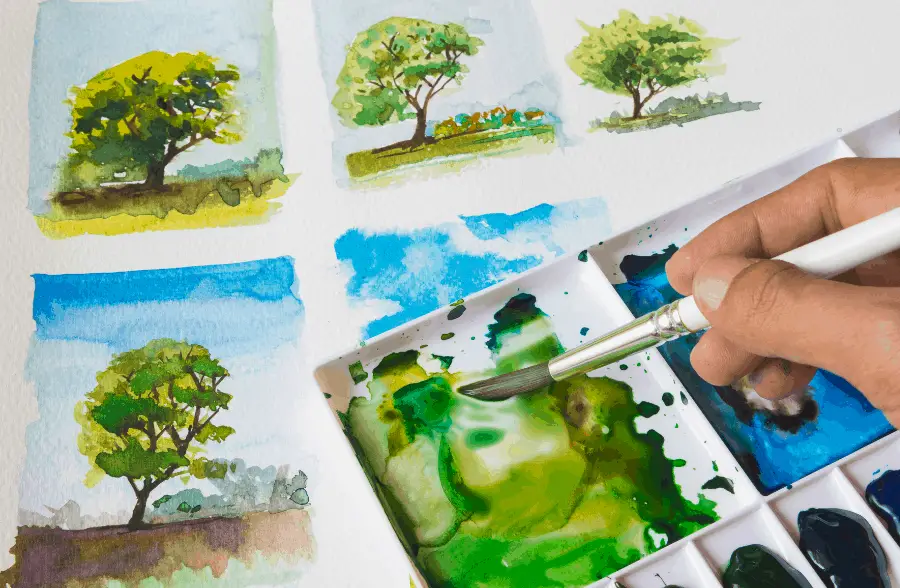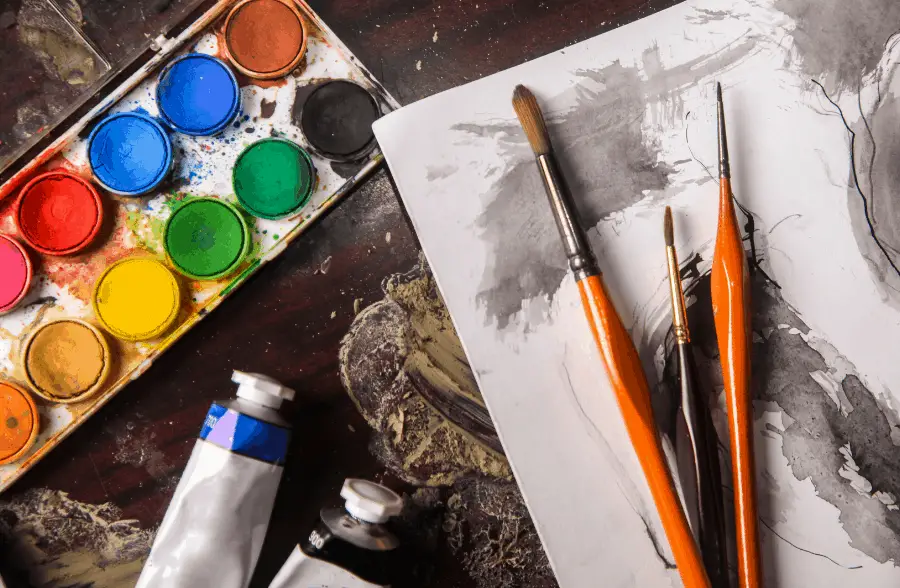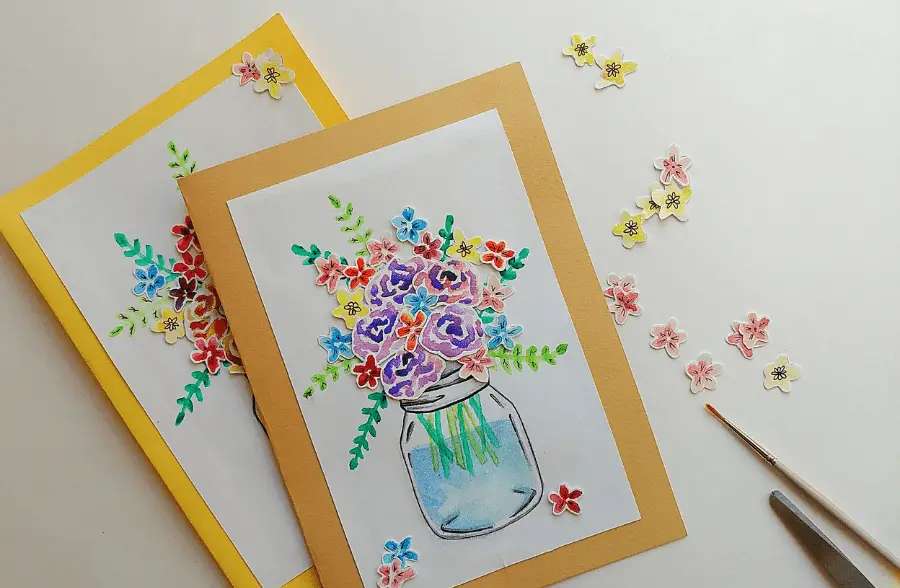Painting with watercolor is a great way to express yourself with an easy medium. Watercolor paints are semi-translucent, meaning it can be hard to make them look as bright and vibrant as you were hoping for. If you notice that your watercolors are looking dull, it could be for a couple of reasons.
So, why are your watercolors dull? Your watercolors might also look dull due to the quality of the paint you are using, the paper, or even your paint brushes. Watercolor paper is very absorbent, so it can result in your paints looking duller when they are dry.
Watercolor typically dries about 30% lighter in color than how it looked wet. This means the colors you use are usually less intense when they are dry. No matter what the reason, there are ways that you can fix your paints to make them look more vibrant and bright. Keep reading to learn more about watercolor paints, and how to make them more vivid and brighter.
Why Does My Watercolor Painting Look Dull?

Your watercolor painting can look dull for a few different reasons. The first thing you should check is the quality of the paint you are using. If the paint is older, it won’t work as well as it used to. Cheaper watercolor paints also don’t have the best quality, which can also impact the dullness of your painting.
My favorite and top pick is always Arteza Watercolor Paints. They have so many different colors, and the quality is amazing! I usually use Arteza Paints for all my projects.

The paper quality can also impact how your watercolor paints look dry. If you aren’t using the right kind of paper, your colors won’t look right. Paper absorbs the water used in watercolor paints, which changes what the color looks like after the drying process. They will typically be lighter and look duller.
I use Arteza Watercolor Paper, and my watercolors always turn out great. The quality is amazing, and it doesn’t cause the paint to bleed. You always want to make sure you have use artists quality paper.

The problem can also be in the paintbrush care and how you handle your paintbrushes. Professional artists take immaculate care of their paintbrushes, and they do so for a reason. If the brush is not in good condition, it will impact how the paints look.

Artegria Paintbrushes are professional level brushes, and they work amazing with the watercolor paint I recommend above. It’s always important to take good care of your brushes, as they can affect the quality of your work.
How Do I Make My Watercolor Brighter?

There are several different things you can do to make your watercolor paints look brighter. First, make sure you leave enough white showing through in your paining. Don’t cover the entire piece of paper with paint, your subject should always have some white to brighten up the piece.
You can also use a lot of paint and a lot of water. It is better to paint with tube watercolors instead of pan watercolors. In the tube, the colors don’t need to be diluted as much.
However, this advice doesn’t mean just adding more water to the paint. It means fully load your paintbrush, make puddles on your page, let the colors flow freely.
Use a real paintbrush with your watercolor paints. A watercolor brush is convenient, but it won’t always allow you to make the best effects. The paints are also too diluted with this kind of brush. It’s best to use a paintbrush with natural hair to get the results you are hoping for.
You can also try to add watery spots of paint to the paper, then drop some more color into it. To do this, don’t wait for the layer to dry before adding more paint to it. Use several colors on top of each other while the first layer is still wet.
Contrast is also incredibly important when trying to make your watercolors look brighter. Use bright and bold colors in your painting. Add wide strokes and little strokes to dark paint. Add details and shadowing where necessary to make the colors pop out more.
How Do You Fix a Mistake on a Watercolor Painting?

Watercolor is pretty unforgiving, which can be really discouraging if a mistake is made. Luckily, there are a few things you can do to fix watercolor mistakes. In some cases, you might see the mistake before the paint has dried. If this is the case, you can try to blot the paint up before it dries.
If your painting is dry and you notice a mistake, you can still fix it. You can do so with a damp brush, sponge, or q-tip. Gently rub the area to lift the dried paint. Make sure you aren’t using more water than necessary, as this can impact other parts of the painting that don’t need fixed.
Some colors will have a greater ability to stain than other colors, making them more permanent. These colors will act in a similar way to dyes, meaning they will stain the paper easier and be more difficult to remove. If you are using one of these staining colors, you can use a Magic Eraser to remove the stain.
How Do You Paint Vibrant Watercolors?

There are a few tips you can keep in mind when you are trying to mix the most vibrant colors possible. First, the brand of the paint does make a difference on how vibrant the colors will look. If the paint you are using is student grade, it is less likely to be vibrant. It is best to use a professional grade watercolor paint.
Avoid mixing too many colors together. If you add too many colors, you might end up with a dull or muddy looking color. A mixture of three pigments or less is usually safe, but when mixing four or more pigments, the color will lose its vibrancy.
In addition to mixing colors, individual paints that have only one pigment instead of multiple pigments can help you achieve more vibrant colors. Most brands of watercolor paints will have the pigments in the paint listed on the tube.
It is also important to avoid using back and forth brush strokes when you are painting with watercolors. Try to skim the paint across the surface and leave it alone. Brushing back and forth can cause both the paint and the surface of the paper to appear dull.
Do You Need to Seal a Watercolor Painting?

It is not necessary to seal a watercolor painting, but it can have advantages. First, watercolor paints are water-based, meaning they can easily be damaged when exposed to water and moisture. This can also cause mold to grow on your artwork, which is less than ideal.
To seal a watercolor painting, it is best to use a wax varnish. Get the varnish and a lint-free cloth. Use the lint-free cloth to pick up some of the wax. Make sure you are using enough, because you don’t want to miss any spots.
I recommend using Sax Tru Flow Varnish for your watercolor paintings. It doesn’t run or leave your paintings yellow, and it’s affordable.
Winsor & Newton is another great brand, but it can be a bit more pricey. They are known for having amazing glosses for oils, acrylics and watercolors.

To varnish your watercolor painting, start at one corner of your painting and work to the right if you are right-handed, or to the left if you are left-handed. It is important to see where you are working. Spread the wax in a circular motion, scooping up more as needed. Cover the entire painting, working right up to the edges.
Let it dry completely before you touch or hang tour painting. I recommend leaving it for at least 24 hours, and if it’s not fully dry, you can leave it for another 6-12 depending on the environment.
Final Thoughts
There is no feeling worse than getting through an entire painting just to have your colors look dull and not as vibrant as you were hoping for. The colors could be dull for a few reasons, starting with the paint, the paper, and the paintbrushes.
There are things you can do to make sure your colors stay vibrant even after the painting has dried. Avoid mixing too many pigments together, leave plenty of white space in the painting, and avoiding painting back and forth with your paintbrush.
Make sure to follow all my tips and recommended products to ensure your watercolor painting turns out amazing. Also, don’t forget to check out my other articles for all your painting Q&A’s. Happy painting!


